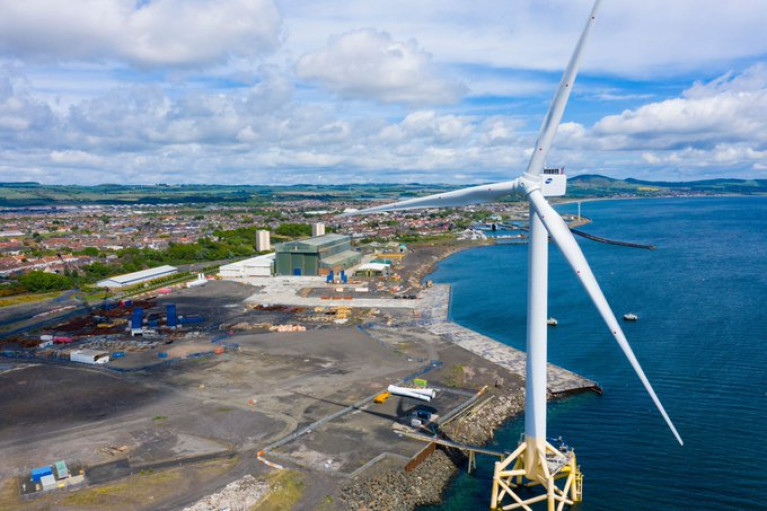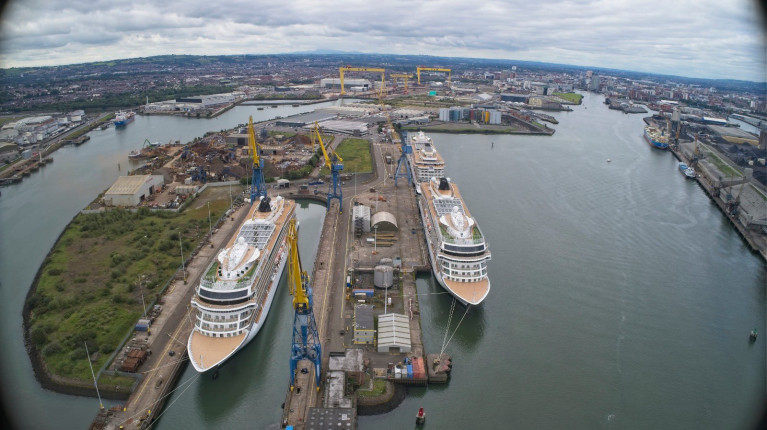Displaying items by tag: Infrastrata
Parent Company, InfraStrata to Trade Under New Name of Harland & Wolff Group Holdings plc
The UK quoted company, InfraStrata plc which focuses on strategic infrastructure projects and physical asset lifecycle management, is pleased to announce it has applied to Companies House to trade under the name Harland & Wolff Group Holdings plc.
The parent company has over the past 18 months, proceeded through various phases which have included, the acquisition of assets, significant upgrades to all its facilities, the introduction of state-of-the-art technology. While simultaneously establishing a substantial sales pipeline which now stands at £7.8bn (on an unweighted) and £1.8bn (on a weighted).
The company is now at its final stage of full reactivation (incl. apprenticeships) of all its yards, which involves building a multi-year backlog for its facilities across its five key markets: defence, cruise and ferry, commercial, renewables and energy. The company believes that this change of name will better reflect its ambition in expanding its core business and the significant development of its shipbuilding and fabrication activities.
The organisation’s flagship Islandmagee gas storage project will retain its name, with management remaining focused on obtaining the Marine Construction Licence and Final Investment Decision (FID) thereafter. Whilst the project now has substantially more life expectancy with the need for major volumes of hydrogen storage (subject to regulatory approvals) it is a relatively straightforward technical change to make in a phased approach as the project transitions from gas to hydrogen over time.
Trading in the company's shares on the AIM market of the London Stock Exchange under the new name of Harland & Wolff Group Holdings plc is expected to take effect as soon as a new stock ticker name has been issued by the AIM team.
An application for the stock ticker “HARL” has been made and will be confirmed as soon as the company’s name has been formally changed at Companies House. A further announcement will be made as soon as regulatory permissions have been secured and the new Company stock ticker has been issued.
In order to reflect the change of name, the company's corporate website will change to www.harland-wolff.com. The information required pursuant to AIM Rule 26 will be available at this address.
John Wood, CEO of InfraStrata plc commented: “We are delighted to make this announcement today, signalling the end of upgrade and reactivation phases. With the new national shipbuilding strategy due to be released in the autumn and the government’s ten point plan for a Green Industrial Revolution, we have confidence that the shipbuilding and fabrication business will deliver substantial value to all our stakeholders as we enter this exciting new stage of building our multiyear backlog of projects.
Since acquiring Harland & Wolff in December 2019, we have seen the organisation grow significantly; in August 2020 we reopened what is now known as Harland & Wolff (Appledore) and in February 2021, we acquired two ex-BiFab sites based in Scotland - now renamed Harland & Wolff (Arnish) and Harland & Wolff (Methil) respectively giving us one of the largest fabrication footprints dedicated to our core markets, in addition to two of the largest drydocks in Europe at Harland & Wolff (Belfast) which at 80% capacity could give sales of in excess of £500m per annum when operational efficiencies have been achieved.
This is a natural progression in building and further developing the Harland & Wolff brand, our commitments to high-quality jobs across our five markets including the 34 apprenticeships recently announced as well as providing socio-economic investment into local, regional, and national communities.”
Shipyard Owner of Harland & Wolff ‘Builds Growth Momentum’
Shipyard owners of Harland & Wolff, InfraStrata has reported "steady progress" in the first months of its financial year.
In a Q1 trading update, the business said it has booked about £6.5m in the eight months to 31 March 2021, with further growth expected this year.
Its cruise and ferry market has broken even after larger contract wins were established.
InfraStrata acquired the assets of the Harland & Wolff shipyard in Belfast from administrators in 2019.
It then further invested in the business by acquiring the Appledore shipyard in North Devon.
Insider has more here on this story.
Afloat adds that InfraStrata in recent weeks acquired the assets of Scottish based Burntisland Fabrication Ltd from the administrators.
These facilities will trade under Harland & Wolff brand and represent the final fabrication piece of its UK footprint.
This will position the company to fully deliver on its existing strategy quicker than it would have done with only its two existing sites: Harland & Wolff (Belfast) and Harland & Wolff (Appledore).
Plans to Raise £9m By Owners of Harland & Wolff (Where Cruiseship Trio Occupy Belfast Shipyard)
Owner of Belfast's iconic Harland and Wolff shipyard, InfraStrata, is set to move forward with its plans to raise £9m.
The company, reports InsiderMedia, first outlined its proposals in early July, with the motion having now been passed by shareholders.
An application has been made for 1,791,428,683 ordinary shares to be admitted to trading on AIM. Following this, InfraStrata's issued share capital will comprise 6,416,008,200 ordinary shares.
Earlier this year, Harland and Wolff secured a £2m asset-backed term debt facility.
The east Belfast facility is where work on ferry and cruise firms have used Covid-19 shutdown to carry out maintenance as The Belfast Telegraph reported last month.
The cruise industry is in the worst crisis in its history as a result of coronavirus, and passenger ferries have also taken a hit in lockdown.
But for Harland & Wolff, itself facing a fight for survival a year ago, the stricken industries are a major source of work as cruise ships and ferries take up residence in its dry docks for maintenance.
Instead of sailing around the world, three ships from Viking Cruises - affectionately called the "three sisters" - are being refitted by H&W staff.
On the same day of the newspaper's report Afloat.ie tracked the cruiseship trio where the Viking Sun was dry-docking within Belfast Dry Dock, the smaller of two such facilities which H&W claim to be the largest dry docks in Europe.
While adjacent to BDD at the fit-out quay were berthed Viking Sea and Viking Sky, the latter ship with nearly 400 people were airlifted during an incident when adrift off Norway last year.
Each of the 930 passenger cruiseships, currently remain at the shipyard, have a gross tonnage of 47,842 and were all built in 2017 except for Viking Sea which entered service the previous year. They were all built in Ancona, Italy following leadship of the series Viking Star which was launched in Marghera also in Italy.
Afloat also tracked the Belfast 'berthed' pair as far back to 1 July at the fit-out berth. Viking Sea having arrived at the Belfast shipyard on 23 June from Alesund, Norway while Viking Sky also carried out the same voyage across the North Sea and arrived the same day.
As for the third cruiseship, Viking Sun was that day in the Irish Sea but having departed Belfast bound for Douglas, Isle of Man. The cruiseship departed the Ulster capital on Wednesday and was expected to arrive offshore of the Manx capital the next day.
During the height of Covid-19, Viking Cruises announced on 11 March that they became the first cruise line to temporarily suspend operations of their ocean and river cruises. This was to ensure a commitment to guests and employees is that safety and wellbeing is always a top priority.
In that spirit, Viking Cruises made the decision to extend the temporary suspension of operations across all sailings through to 30th September.































































